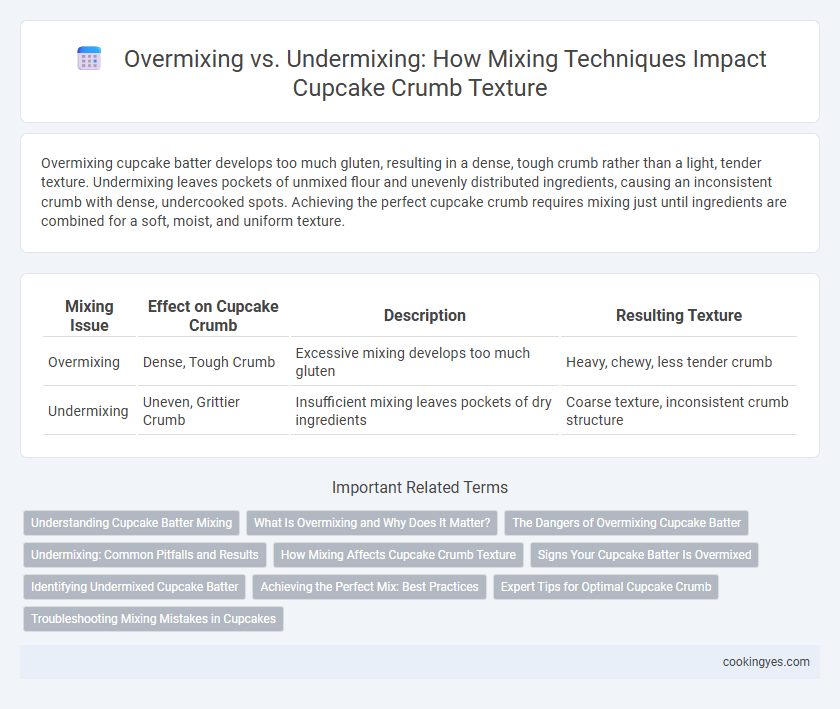Overmixing cupcake batter develops too much gluten, resulting in a dense, tough crumb rather than a light, tender texture. Undermixing leaves pockets of unmixed flour and unevenly distributed ingredients, causing an inconsistent crumb with dense, undercooked spots. Achieving the perfect cupcake crumb requires mixing just until ingredients are combined for a soft, moist, and uniform texture.
Table of Comparison
| Mixing Issue | Effect on Cupcake Crumb | Description | Resulting Texture |
|---|---|---|---|
| Overmixing | Dense, Tough Crumb | Excessive mixing develops too much gluten | Heavy, chewy, less tender crumb |
| Undermixing | Uneven, Grittier Crumb | Insufficient mixing leaves pockets of dry ingredients | Coarse texture, inconsistent crumb structure |
Understanding Cupcake Batter Mixing
Overmixing cupcake batter causes gluten overdevelopment, resulting in a dense and tough crumb, while undermixing leads to uneven ingredient distribution and a coarse, crumbly texture. Optimal cupcake crumb requires mixing just until ingredients are combined to maintain a tender structure with uniform air incorporation. Understanding this balance ensures a moist, soft cupcake crumb with consistent rise and delicate texture.
What Is Overmixing and Why Does It Matter?
Overmixing cupcake batter incorporates excessive air and develops gluten strands too much, resulting in a dense, tough crumb instead of a soft, tender texture. This process disrupts the delicate balance needed for a light, fluffy cupcake by causing the crumb to become rubbery and unevenly baked. Understanding overmixing is crucial for achieving the ideal cupcake crumb structure and optimal mouthfeel.
The Dangers of Overmixing Cupcake Batter
Overmixing cupcake batter causes excessive gluten development, resulting in a dense, tough crumb instead of a tender, light texture. This process traps too much air, leading to cupcakes that rise rapidly and then collapse, creating tunnels and uneven crumb structure. To achieve a moist, fluffy cupcake crumb, it's crucial to mix just until the ingredients are combined, preserving the delicate balance for proper aeration and crumb formation.
Undermixing: Common Pitfalls and Results
Undermixing cupcake batter often leads to uneven distribution of ingredients, resulting in dense, heavy crumbs with pockets of flour or unmixed butter. This common pitfall prevents proper gluten development and air incorporation, crucial for achieving a light, tender crumb structure. Undermixed cupcakes typically exhibit inconsistent texture, dry spots, and poor volume, detracting from the overall eating experience.
How Mixing Affects Cupcake Crumb Texture
Overmixing cupcake batter leads to gluten overdevelopment, resulting in a dense, tough crumb, while undermixing causes uneven distribution of ingredients, producing a crumb with tunnels and crumbly texture. Proper mixing ensures a uniform batter that traps air, creating a light, tender, and moist cupcake crumb. Monitoring mixing time and speed optimizes crumb structure, balancing tenderness and fluffiness in the final cupcake.
Signs Your Cupcake Batter Is Overmixed
Overmixed cupcake batter appears dense and glossy with a thick consistency, leading to a tough, rubbery crumb after baking due to gluten overdevelopment. You may notice air bubbles bursting prematurely, causing tunnels and uneven texture within the cupcake. Proper mixing stops once ingredients are just combined to avoid these signs and achieve a light, tender crumb.
Identifying Undermixed Cupcake Batter
Undermixed cupcake batter contains visible streaks of flour and lumpy textures, leading to a dense, uneven crumb structure after baking. This incomplete incorporation of ingredients prevents proper gluten development, resulting in pockets of dry flour and a heavy, coarse crumb. Identifying undermixed batter early is crucial to achieving a tender, uniform cupcake crumb with optimal rise and softness.
Achieving the Perfect Mix: Best Practices
Achieving the perfect cupcake crumb requires balancing mixing time to avoid overmixing, which can result in a dense, tough texture due to excess gluten development, and undermixing, which causes uneven crumb and large air pockets. Best practices include gently folding dry ingredients into wet ingredients just until combined, ensuring a uniform batter without excess gluten activation. Using a low-speed mixer or mixing by hand can help maintain optimal batter consistency, resulting in a soft, tender crumb with even texture.
Expert Tips for Optimal Cupcake Crumb
Overmixing cupcake batter develops excess gluten, resulting in a dense, tough crumb, while undermixing leaves uneven pockets of flour causing a coarse texture. Expert bakers recommend mixing just until ingredients unify, typically stopping as soon as no dry flour streaks remain for a tender, moist crumb. Using a spatula or low-speed mixer and folding gently preserves air bubbles, ensuring a light, airy cupcake crumb.
Troubleshooting Mixing Mistakes in Cupcakes
Overmixing cupcake batter develops excessive gluten, resulting in a dense, tough crumb that lacks tenderness, while undermixing leaves pockets of flour and uneven ingredient distribution, causing a crumbly, inconsistent texture. Troubleshooting mixing mistakes involves gently folding ingredients until just combined to achieve a light, moist crumb with uniform crumb structure. Prioritizing proper mixing time and technique prevents common issues like tunnel formation and dry cupcakes, ensuring optimal softness and crumb quality.
Overmixing vs Undermixing for Cupcake Crumb Infographic

 cookingyes.com
cookingyes.com